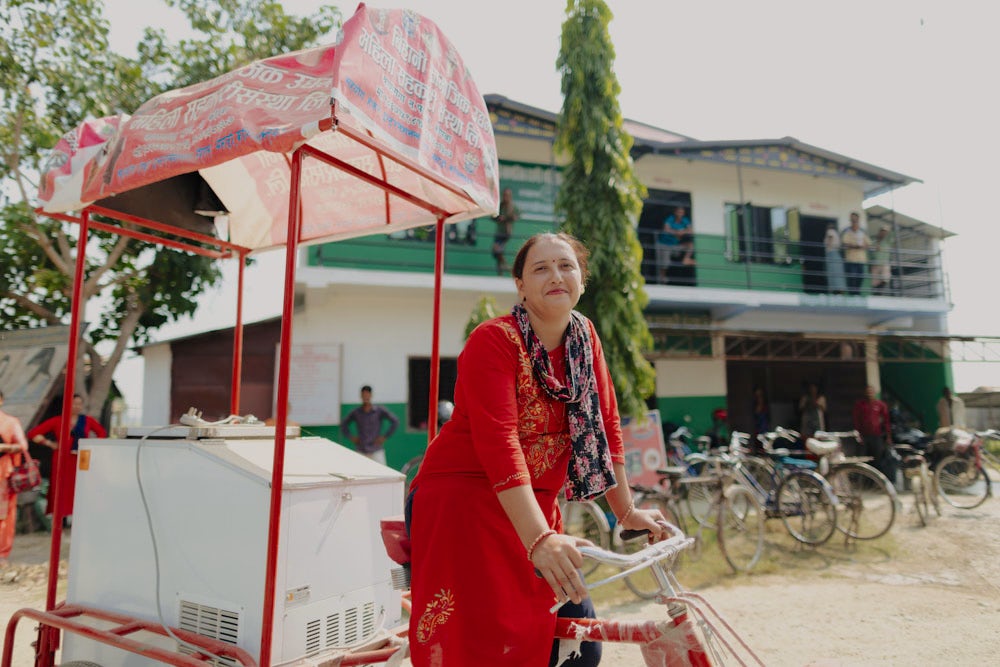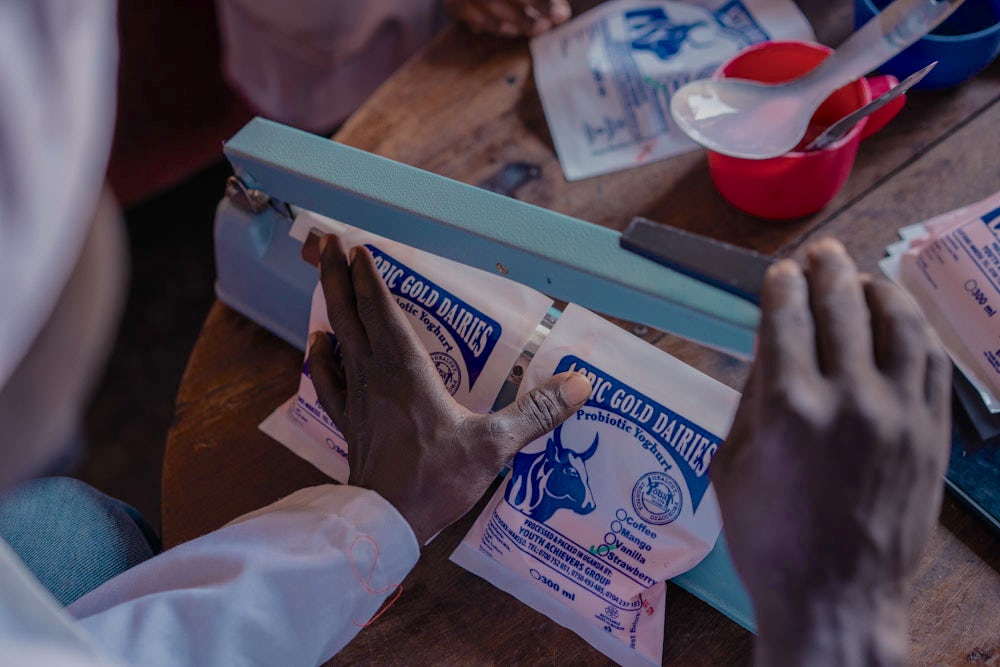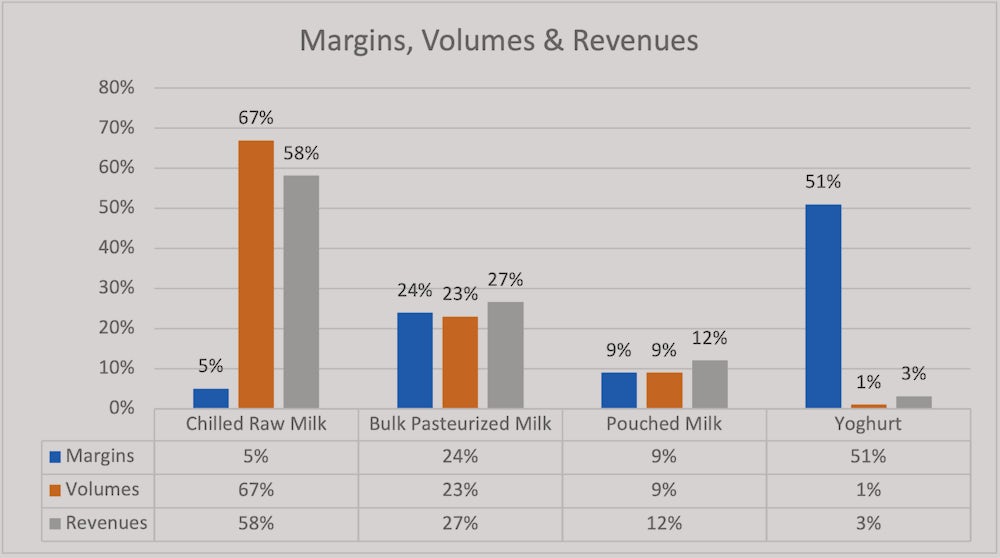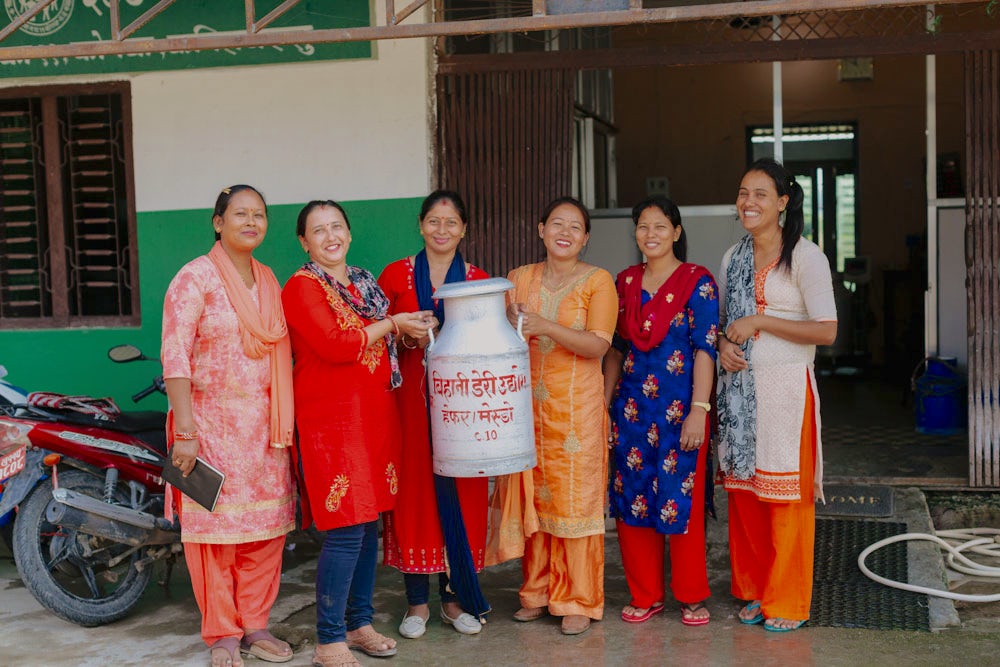Several years ago the women of Bihani Dairy, a Heifer-supported agricultural cooperative in southwestern Nepal, had an idea: Provide a collection center for milk produced by the area’s dairy farmers, an enterprise move that would reduce waste and offer farmers, who were otherwise forced to sell as quickly as possible for below-market fees, a chance to create a Sustainable Living Income.
This opportunity generated others, such as using the milk to produce more diverse “value-added” dairy products, like yogurt, ghee and kulfi, or ice cream — adding potential for profit every step of the way.

“We are also in the process of diversifying the milk into various products in a larger volume so that milk does not have to go to waste,” said Thulsi Thapa, chairperson of Bihani Dairy, which even more recently is planning to expand its operations and market its brand across the region. “We are hopeful that the future holds better prospects for us.”
Heifer International believes farmer-centered agricultural value chains, like the dairy chain leveraged by the women of Bihani, are a critical pathway to help vulnerable people provide nutritious food for their families and communities while earning a fair wage for themselves.
But what is a value chain, exactly?
A value chain is the entire sequence of activities performed to create and deliver a product or service, in which value is added at each phase of the process. An agricultural value chain refers specifically to agricultural products, like milk, and is defined by the Food and Agriculture Organization of the U.N. as the set of actors and actions that bring a basic farmed product from field production to final consumption, with the product gaining value along the way.
A value chain comprises everything from the conception or design of a product to its final sale, including sourcing raw materials, production, manufacturing, marketing, distribution and customer service, as well as supporting business operations, like quality control, accounting and human resources.

The value chain for exported Guatemalan cardamom, for example, starts with smallholder spice farmers and includes agricultural inputs, like cardamom seed and fertilizer; crop production, such as sowing and harvesting; cardamom drying; processing; packaging; transportation and shipping; sale to international markets; and final retail sale.
Another example of a value chain is the dairy sector in East Africa, which also starts at the farm level and covers all the equipment and activities that move milk from the field to the consumer, including production of cattle feed, production and collection of milk, transportation and cold storage, processing, packaging, distribution to markets and sale to the end customer.

Throughout the value chain, the product improves in quality and convenience or is processed into other desirable products, becoming more valuable at every stage. Each link in a value chain is also an opportunity for the farmer to earn more income.
“If a farmer sells raw milk to a processor, for instance, they are not going to earn very much money for it,” said Mike Heald, Heifer’s vice president of investment programs, who leads investment initiatives that enable farmers to participate more equitably in the value chains for the products they produce.
“But if they are equipped with infrastructure and equipment to sell it to a consumer as yogurt, they get the value addition of going from raw milk to pasteurized milk to yogurt, or even cheese, and the profit from the effort gets paid back to the farmer.”

Building strong, equitable agricultural value chains — that feed into a sustainable, inclusive food system — is important to meeting the United Nations Sustainable Development Goals of overcoming poverty and feeding the world’s growing population. And this work cannot be accomplished without lifting up farmers.
Despite the labor they put into growing and producing food, the world’s smallholder farmers — having limited access to financing, markets or equipment to expand operations or process their products — often reap the least financial benefits. Nearly 65% of the extreme poor and over half the moderately poor in developing countries make their living through agriculture. Even in the U.S., growers and ranchers earn just 14.3 cents of every dollar spent on domestically produced food.
“A lot of times, value chains are set up in a way that takes advantage of the work farmers do,” Heald said. “They evolved over time so that the use of capital and technology to improve the value of commodities excluded the farmer.”
Heifer Impact Capital, Heifer’s private investment entity, is working to change this dynamic, deploying financing like loans and equity investment to optimize local agricultural value chains to keep income in the pockets of farmers.
Research backs this effort: Growth in the agriculture sector is estimated to increase the earning potential of poor families two to four times more effectively than other industries.
“What we look for is opportunities to disrupt the value chain for the benefit of the farmers,” Heald said.
In partnership with Heifer’s country teams, Heifer Impact Capital assesses local markets and value chains, identifying areas where farmers are losing profit or where there is a missed opportunity for income, then financing projects that empower farmers to take more ownership of those links in the chain.
In Guatemala, for example, an investment in new dryer technology is helping cardamom farmers earn more for their crop. The spice rots within 12 hours of harvest if the drying process isn’t initiated, forcing growers to sell to middlemen immediately — and for as little as is offered — or risk making nothing at all. Cardamom is worth up to five times more dried than fresh, and taking over the drying process gives farmers more time to negotiate a fair price.
Heifer Impact Capital also invested in a new Guatemala-based spice company, Nueva Kerala, which gives local farmers a role in processing, packaging and distributing cardamom and other spices for the export market. And in Kenya, investments in machinery for chilling, pasteurization and making yogurt are supporting dairy farmers to reap a higher price for the milk they produce.

Around the world Heifer Impact Capital advocates for farmers — like those in Guatemala and Kenya, the women of Bihani and thousands of others — and invests in infrastructure and equipment that expand the stake they have in the value chains they supply. This translates to more income at the farm level — and more resilient families, economies and communities on a global scale.
“Our goal is to help farmers participate in the value chain as far through the chain as possible,” Heald said. “Everything we do is trying to create a living income for smallholder farmers around the world.”